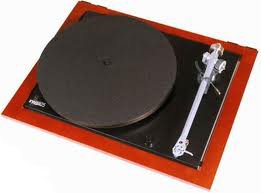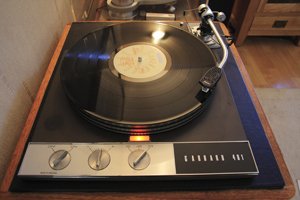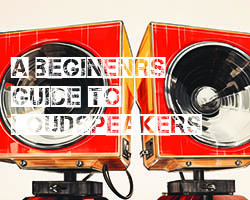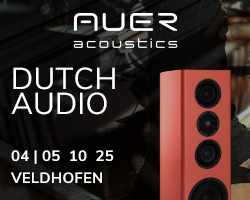I remember as a youngster seeing my first Dansette record player which my uncle used to spin up Elvis singles and thought it was the bees knees! That’s what really got me into vinyl, the diverse range of albums that relatives owned and regularly played. It just left an indelible impression that music over the airwaves didn’t seem to capture as well for me. I vowed on day to own a Dansette!
Time moved on, and no I never got to own a Dansette (although the historical interest means I may yet search one out!). Of the record decks that have been through my hands, three have stuck out for me as defining moments in my hifi journey. I’ll say, before I start, that these are not meant to be a comparison with other decks, but are quite personal to me for reasons I’ll go on to explain.
Rega P25
I stared out with a Dual 505-2 and whilst an inoffensive and pretty decent starter deck, it was nothing special and I never really minded selling it on. Following a brief affair with a Thorens TD260 which as ok too, I bought what I considered to be my first quality hifi deck which was the Rega Planar P25 in a Rosewood plinth surround. The attraction with this deck, was that it was and still is (for me) quite a statement. It was Rega saying “we’ve been around 25 years now and this little gem proves we can do quality at a sensible price”. That it was. Very nicely finished, the P25 filled the gap between the P3 and P9 decks. The platter may have been taken from the P3 but the plinth was more like the upmarket version used on the P9.  The big upgrades over the P2 and P3 decks, besides the RB600 arm included the motor where the twin pots were hand adjusted to reduce resonance and the mounting was better isolated than the P3. The arm had improved bearing tolerances over the P3, was finished in anodised silver and used the same wiring as the P9, with klotz cable and Neutrik Profi RCA’s. All in all, it was a pretty remarkable deck for the princely some paid of £485.
The big upgrades over the P2 and P3 decks, besides the RB600 arm included the motor where the twin pots were hand adjusted to reduce resonance and the mounting was better isolated than the P3. The arm had improved bearing tolerances over the P3, was finished in anodised silver and used the same wiring as the P9, with klotz cable and Neutrik Profi RCA’s. All in all, it was a pretty remarkable deck for the princely some paid of £485.
So how did it sound? In a word, great. Easy to set up, easy to use and rewarded with an open soundstage and great timing. However, (as there’s always one), I never really got on with that arm. To get VTA adjusted was fiddly to say the least and I resorted to mountain bike Ahead set spacers (!) until I got the arm shimmed to the correct level when fitting cartridges other than Rega’s own brand MM carts. I tried a few but they were in my personal view quite dull and lacking at the frequency extremes, even the Super Elyse.
The arm really boogied with Goldring’s 1042gx and Sumiko’s BPS EvoIII though! One thing that grated no-matter what cart was fitted was some mid-upper resonance and upper frequency harshness. I tried everything in the hope it wasn’t the arm. I swapped out ‘speaker cables, IC’s and even moved the hifi set up into another room! It never improved matters much. I guess it was this that finally persuaded me to move that deck on, as changing the glass platter for acrylic didn’t bring any improvements, nor did the swap to using a Technoweight set up. Whilst a well made and pretty decent deck, and contrary to all the rave reviews of the time, I just couldn’t live with that arm.
Michell Gyro SE
Enter the Michell Gyrodec SE. This has always been a deck for me to aspire to, most especially because it’s purchase price (minus arm) of around £1200 was outside my grasp. In my personal opinion it looks as good now as it did when it first came out all those years back. In fact, “coming out” may be a great description, as the deck has really evolved rather than been a new invention and says “never mind what I once was, look at me now, aren’t I stunning?”. This is not an unkindness to the original Transcriptors which Michell made under licence at one point, as that remains a superb looking and performing deck and is still available today for a significant premium over the Gyro.
it first came out all those years back. In fact, “coming out” may be a great description, as the deck has really evolved rather than been a new invention and says “never mind what I once was, look at me now, aren’t I stunning?”. This is not an unkindness to the original Transcriptors which Michell made under licence at one point, as that remains a superb looking and performing deck and is still available today for a significant premium over the Gyro. 
The Gyro can trace its roots back to the Transcriptors Hydraulic Reference Deck for which some styling queues are still evident on it today. The round platter weights are still there, albeit now under-slung; the purposeful and industrial look (that’s probably unfair…perhaps “solid architectural” is a better description) has remained, and the original Transcriptors Genes are still pretty evident. The main difference, besides the inversion of the platter weights, are the off board drive motor and suspended chassis with the arm board mount incorporated at one end of it.
Its a clever design in many ways. It enables arm interchangability via bespoke mounting plinths available from Michell, has nifty adjustable feet to get level spot on, and uses a sprung chassis to eliminate footfall resonances. A closer inspection reveals the underside of the chassis is heavily damped using tacky black damping material and the engineering quality is peerless. I had the TechnoArm(A) fitted to start with which was a big improvement over the RB600. It had the VTA adjustment, the Technoweight and importantly it had some of the resonance issues which I suspected of the standard arms mitigated. Michell did this by drilling the arm, using a shot peened finish and improving the internal damping. So it wasn’t just my imagination and Michell considered that this was one area that could be improved upon! I had fitted a Goldring Eroica MC cartridge after destroying my second BPS EvoIII (that nude cantilever just asks to be snagged!).
Soundwise, the first impressions were that whilst the P25 had been airy and detailed sounding, the Gyro was more solid and authoritative. Bass was better defined and deeper and more detail just seemed to get through. I think in part this was not just the arm, but the solid plinth which is a huge improvement over the glass platter of the Rega. Michell say that this is made from a composite with similar resonance characteristics as the LP itself, so when the record clamp is used in essence, you get a big heavy thick LP which is less prone to unwanted resonance feedback to the stylus. Listening impressions confirm this is the case. A short period of time convinced me that this deck could do better and in keeping with my (by now) suspicions about Rega arm variants, I swapped the arm for an SME309. Fitted to the Gyro, this is a marriage made in heaven.
Not only did the arm addition improve the clarity and detail of the upper registers, it reinforced that solid architectural sound that I found with the Michell. It elevated the deck to a truly authoritative performer, and whilst I have little doubt that the Orbit deck improves on this further, The Gyro is probably all the deck I’ll ever want or need.
Enter the Garrard 401
My late Father in law, a few years before passing away, gave me his Garrard 401 as he had stopped using it in favour of his CD player. The plinth was a rather flimsy home built affair and the arm was a well used and abused Connoisseur tonearm with a Shure MD75 ED fitted. The first thing I did was strip everything apart. Plans were obtained and a new plinth was built from triple laminated MDF, braced underneath and using a solid tropical hardwood surround. I sold the arm and bought a good Used SME3009 improved version and fitted this with a NOS Sonus Blue Gold line contact moving Iron cartridge. The deck was inspected, joints oiled, thrust bearing oiled and some fine adjustment and the odd bit of re-wiring done before reassembly.
I like this deck. On first impressions when sat in its smart new plinth, I thought what a nice piece of solid British engineering it represented, but wasn’t expecting anything special when the needle first hit the grooves. I was about to be surprised…what immediately struck me was the solid and deep bass performance and lovely mid range. How much of this was the deck and how much the arm/cart combo I didn’t know so tried the deck with the old arm and cart. Whilst not a patch on the replacements, the bass solidity stayed. Impressive. With rock, the deck is fantastic, and with classical some rumble could be heard on quieter passages indicating that my plinth design could be improved on and perhaps the main bearing could do with replacement, but all hyper-critical comments as the rumble is barely audible.
The biggest surprise for me though is that I prefer the 401 to the P25, even if that 3009 should be outclassed by the RB600, I just can’t hear that it is! The deck is easy to set up, looks a million dollars and I’ve o doubt that with the odd service, it will still be going in 30 years time. And that’s the point I guess. Like it’s more sought after sibling, the 301, Garrard got it right first time out with the 401 and it remains as popular today as it was 30 or 40 years ago and a darn sight more accessible. This and the 301 were was the high end decks of their day. The introduction of the first LP12 drew hifi crowds away from the 401, and that was a travesty as the early LP12’s simply couldn’t hold a candle to either of the Garrard decks. I think people are realising it’s potential these days and prices and desirability are on the up as a result. Fit it with whatever arm you like, make sure it remains well serviced (only the motors drying out can end the life of the deck prematurely) and it will reward for many years to come.
So what’s the conclusion? Something of a surprise. One would have had reasonably expected the P25 to represent best value, and that it possibly still manages (just) as used prices are now around £200 to £300, as with some well used 401’s (which may need a bit of attention). But is the P25 better than the 401? Sonically I’d say not but with a big caveat. The Garrard needs to be set in a decent plinth and fitted with an arm to do it justice and that motor rumble isolated as well as possible. Do that, and my money’s on the 401 all day long. Can either really compete with the Gyro? Those wearing rose tinted glasses may think so, and the Garrard comes mighty close, but to my mind, the Gyro excels with all genres of music and retains supreme clarity and authority. It makes a very attractive used buy too with the levels of customer service offered by Michell being second to none, so spares and service should never be a problem. Truth is I like both the Gyro and 401 equally for different reasons and could never part with either to pool the resources for an upgrade. Whilst the Gyro embodies the evolution of ideas into what it is today, the 401 remains today what it was and without that evolution. Both are iconic in their own respective ways. One is set to become a classic and one is already a classic, and both allow pride of ownership and recognition of their strengths and heritage without being tempted to move them on, all in my humble opinion.
Author – Paul
Want to read more hifi reviews?


































































































































































































You must be logged in to leave a reply.